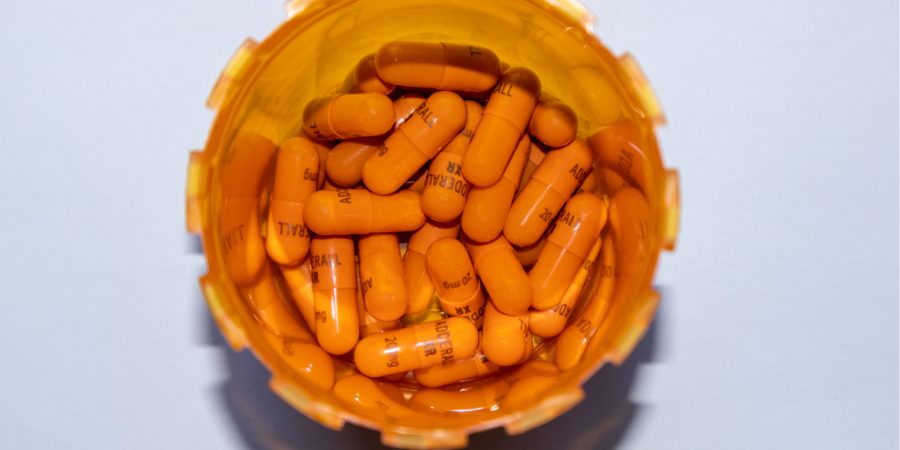

Most people are probably aware that amphetamines, like Adderall, are chemically similarly to methamphetamine—commonly known as meth. Both Adderall and meth are central nervous system (CNS) stimulants, meaning that they stimulate the circulatory systems and certain regions in your brain to increase feelings and impulses of excitability, paranoia, euphoria, and compulsive behaviors. But what is the actual, medical difference when it comes to Adderall vs. meth?
Table of Contents
What Is Adderall?
Adderall is a brand name medication that is FDA-approved for treating both ADHD and narcolepsy, a sleep disorder. This medication helps improve attention and focus in people with ADHD and increases wakefulness in people with narcolepsy.
Adderall is an amphetamine, a class of compounds that works by increasing the activity of neurotransmitters in the brain. When it comes to Adderall vs meth, one big difference is in appearance. Adderall comes in a pill, whereas meth is most often seen as a powder. Adderall is composed of two amphetamine salts, amphetamine, and dextroamphetamine, and is available in both immediate-release and extended-release tablet formulations.
What Is Meth?

Meth is a chemically synthesized illicit drug. Crystal methamphetamine, which you may have heard of as crystal meth, is just one form of meth. Several differences exist when comparing crystal meth vs. meth. Meth is usually snorted, smoked or injected, while crystal meth is generally smoked.
Meth typically appears as a white, crystalline powder, but may also appear brown, yellow-gray, orange or pink and can be formed into a pill. Crystal meth is a distilled, highly potent form of meth that looks similar to glass fragments or bluish-white rocks. A major difference between Adderall and meth is in how they are used. Illicit forms of meth are used to generate pleasurable, euphoric feelings and increased energy.
A legal meth form is also available under the brand name Desoxyn. Prescription Desoxyn, or its generic form methamphetamine hydrochloride, is FDA-approved to treat ADHD and obesity. The use of prescription meth for ADHD has become much less common, as newer drugs such as Adderall have become increasingly popular.
What Is the Difference Between Amphetamine and Methamphetamine?
On a chemical level, meth and Adderall are almost identical. However, the difference between Adderall vs. meth is a single additional chemical group called a “methyl” group on the structure of methamphetamine, for which it is named.
It is believed that the extra methyl group in methamphetamine allows the drug to cross the blood-brain barrier quicker than other amphetamines. When comparing Adderall vs. meth, this makes meth a more potent drug with a quicker high and a more severe side effects.
Abuse is risky and harmful for each. Both amphetamine and methamphetamine drugs make their way to the streets for sale and are both used recreationally. People will buy meth for its high and amphetamines for weight loss or study focus. However, there are no safe means of using either of these drugs without a doctor’s supervision.
It’s difficult to directly compare the strength of Adderall vs. meth. Adderall comes in immediate-release and extended-release pills. The pills range from five-milligram to 30-milligram doses. However, the strength of meth that’s bought on the street is often very difficult to determine. This makes the risk of overdose much higher.
Most people have no idea how strong or pure street meth is. Most of it is mixed with other substances that may affect how strong it feels. In recent years, deaths in Las Vegas from laced meth purchased on the street have risen.
Fentanyl is used increasingly often as a cheap filler which may produce more intense effects for users. This mixture is particularly dangerous, not just because of the high overdose potential of fentanyl but also because of the unpredictable and dangerous interaction between meth and fentanyl.
Adderall vs Meth: How Addictive Are They?
The abuse of stimulant drugs can lead to permanent damage to the brain, often leading to psychosis, aggression, and suicidal/homicidal behaviors. In a 2019 report by the Substance Abuse and Mental Health Agency (SAMSHA), with 68 million reported users, amphetamines and other stimulant drugs come second in rank of illicit drugs that are abused. Amphetamine dependence could produce symptoms of depression, anxiety, and psychosis. Individuals who experience withdrawals from amphetamines can expect:
- Fatigue
- Recurring Vivid Dreams
- Increased Appetite
- Motor Impairment
- Mood Swings
Medications such as Adderall are highly addictive if taken beyond the prescribed use. Amphetamines produce an intense desire to redose, and the cravings for amphetamines usually begin shortly after use has stopped. This is why extended release capsules may be effective in lowering your addiction risk.
Both drugs alter the levels of chemicals involved in the brain’s reward pathways, motivating individuals to continue seeking them out. The addiction potential is lower for Adderall vs. meth, but the availability of Adderall and its “safer” perception make it a common target of abuse.
Adderall addiction is particularly common among college students who use it to improve concentration or academic performance. Amphetamine addiction statistics demonstrate that in 2018, approximately 1.9 million people aged 12 or older reported using meth in the past year, and 5.4% of people 12 and over reported using meth in their lifetime. About 15% of all drug overdose deaths in 2017 involved meth.
Individuals using amphetamines over an extended period of time generally develop a dependence on the drug. This dependence leads to greater and greater dosages, which in turn increase the cravings for the drug. Without the help of a professional treatment program, attempts to stop amphetamine abuse may fail due to its difficult withdrawal symptoms.
Getting Help for Amphetamine Addiction

Detox for amphetamines vs methamphetamines is often a straightforward, if difficult, process. Withdrawal symptoms often begin within 24 hours after use has stopped. The first wave of withdrawals usually takes place within the first few days. Typically, the cravings for the drug mostly subside after two weeks, but it can take much longer to address the issues underlying the addiction.
For long-term recovery, members should explore an inpatient treatment option. Behavioral therapies and group support help provide the care and attention the patient needs. Cognitive behavioral therapy, or CBT, is a comprehensive approach to tackle the compulsions that enable addiction. Developing proper coping skills and life strategies is the best way to ensure that the changes you make, stick.
The programs at the Veteran’s Journey Recovery Center are evidence-based and holistic in nature, meaning that each person and their individual circumstances are taken into consideration when developing a treatment plan for methamphetamine recovery. Additionally, our inpatient and residential programs provide a comfortable, therapeutic setting that supports growth.
A few of the treatment therapies available at the Veteran’s Journey Recovery Center include:
- Individual and group therapy
- Complementary therapies (i.e., yoga and recreational therapy)
- Cognitive behavioral therapy (CBT)
- Dialectical behavior therapy (DBT)
- Acceptance and commitment therapy (ACT)
- Motivational interviewing (MI)
- Mindfulness and meditation
- Trauma-informed care
- Eye movement desensitization and reprocessing (EMDR)
- Clinical hypnotherapy
- 12-step recovery groups
At the Veteran’s Journey Recovery Center, we will support you throughout a continuum of care that extends to before, during, and after treatment. Deciding to commit to meth rehab is a huge first step in recovery. To get started, contact an admissions specialist at 888-828-2623 or use our confidential online contact form
The post Adderall vs Meth: What’s the Real Difference? appeared first on VJRC.
Source
Original Author: Veteran’s Journey Recovery Center

